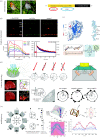Cryptochromes--a potential magnetoreceptor: what do we know and what do we want to know?
- PMID: 19906675
- PMCID: PMC2844001
- DOI: 10.1098/rsif.2009.0411.focus
Cryptochromes--a potential magnetoreceptor: what do we know and what do we want to know?
Abstract
Cryptochromes have been suggested to be the primary magnetoreceptor molecules underlying light-dependent magnetic compass detection in migratory birds. Here we review and evaluate (i) what is known about these candidate magnetoreceptor molecules, (ii) what characteristics cryptochrome molecules must fulfil to possibly underlie light-dependent, radical pair based magnetoreception, (iii) what evidence supports the involvement of cryptochromes in magnetoreception, and (iv) what needs to be addressed in future research. The review focuses primarily on our knowledge of cryptochromes in the context of magnetoreception.
Figures


References
-
- Adair R. K. 2000. Static and low-frequency magnetic field effects: health risks and therapies. Rep. Prog. Phys. 63, 415–454. (10.1088/0034-4885/63/3/204) - DOI
-
- Ahmad M. 2003. Cryptochromes and flavoprotein blue-light photoreceptors. In Handbook of photochemistry and photobiology (ed. Nalwa H. S.), p. 4 San Diego, CA: Academic Press.
MeSH terms
Substances
LinkOut - more resources
Full Text Sources
Medical
